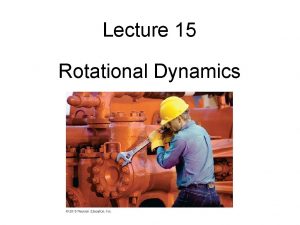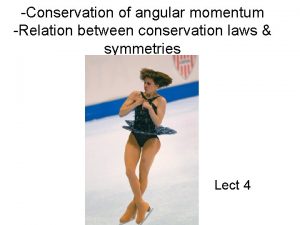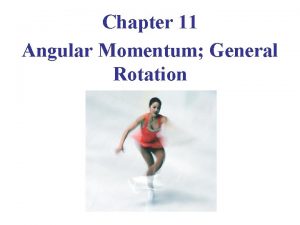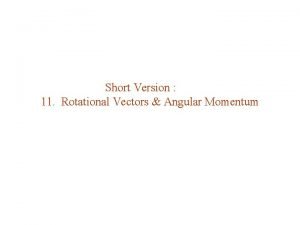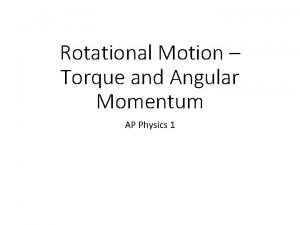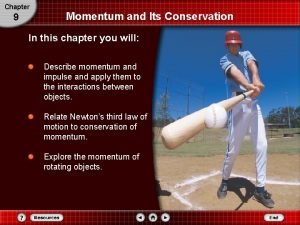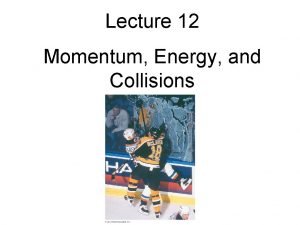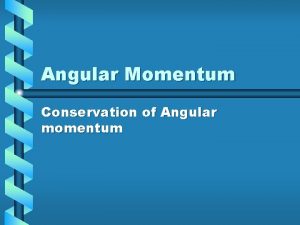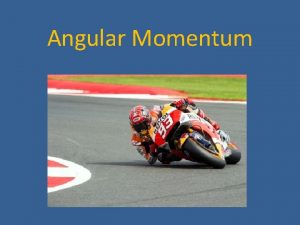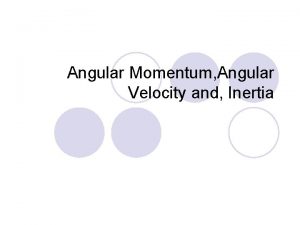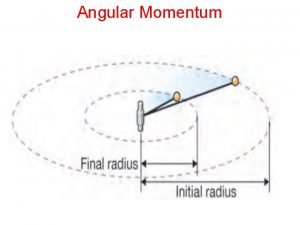Conservation of Angular Momentum Change in Angular Momentum






- Slides: 6

Conservation of Angular Momentum, Change in Angular Momentum and, Angular Impulse October

Conservation of Angular Momentum l Lmom is a conserved quantity/remains constant in the absence of an external force (i. e. torque) l Since Lmom is a constant for an isolated system, and because the Lmom formula can be rearranged to give v = Lmom /(mr), the velocity v and the separation r are inversely correlated. l thus, conservation of angular momentum demands that a decrease in the separation r be accompanied by an increase in the velocity v, and vice versa. l We observed this during our Ironman demo: mr. BIGvsmall Another example = mrsmallv. BIG

Change in Angular Momentum l How do we deal with a change in angular momentum (∆ Lmom or ∆ Iω)? l The same way we did with a change in linear momentum l Recall, for linear momentum: Change in linear momentum = ∆P= m∆v l Same for change in angular momentum except symbols change: Change in Angular momentum = ∆ Lmom = I ∆ ω where ∆ ω = ω2 - ω1 l Let’s try Example 2 part “a” from pg. 56

Angular Impulse l Recall from linear impulse that J=F∆t which means that a linear impulse is the result of a force applied in a certain amount of time ex. Hydraulic spreader (HUGE jaw force applied to outer edges of car door for 1 min results in HUGE IMPULSE to pry open door) l l l Angular Impulse is what causes objects to start or stop rotating Like linear impulse it still happens in a certain amount of time EXCEPT, since rotation, the force required to start that rotation is called TORQUE is a force applied from a certain distance from the center of object such that; Torque(T) = Fxd where F(N or lb), d (m or ft), T (N. m or lb. ft)

Working with Angular Impulse l l Angular Impulse causes rotation when torque (F x d) is applied to an object in a certain period of time. Screw begins to turn due to angular impulse applied from wrench Ang. Imp. = (Fxd)∆t where Ang. Imp. has units (N. m). s or (lb. ft). s l we could re-write equation as Ang. Imp. = T∆t l And of course don’t forget: Impulse (in this case angular impulse) is what causes change in momentum so: T∆t = I∆ω l Let’s try part “b” of Example 2 pg. 56

Classwork/Homework (whatever is not finished in class must be finished for hmwk) l Read pg. 44 -50 l Complete Qd-g from Let’s Review units on pg. 55 l Complete Student Exercises(#1 -11) on pg. 51. You must write out the full question for Q 1 -10 and use GFS for #11. l Answer Qs #4 -6 on pg. 57 of workbook
